VC&G Interview: Robert Tinney, BYTE Cover Artist and Microcomputer Illustration Pioneer
September 26th, 2006 by Benj Edwards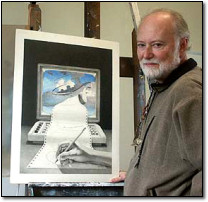 If someone wrote a book on the history of personal computer art, chapter one could only bear the name of one man: Robert Tinney. As cover artist for over eighty issues of BYTE magazine — microcomputing’s first and finest major publication — and as one of the first men to illustrate topics related to the fledgling field of personal computers, he near single-handedly shaped the popular visual idiom of what computers were, could be, and would be for the for a whole generation of microcomputer enthusiasts.
If someone wrote a book on the history of personal computer art, chapter one could only bear the name of one man: Robert Tinney. As cover artist for over eighty issues of BYTE magazine — microcomputing’s first and finest major publication — and as one of the first men to illustrate topics related to the fledgling field of personal computers, he near single-handedly shaped the popular visual idiom of what computers were, could be, and would be for the for a whole generation of microcomputer enthusiasts.
That proud generation has long since grown up and moved on to a myriad of different fields and disciplines, spreading its knowledge, love, and expertise of all things technological around the world. Collectively, they have arguably become the world’s most influential, yet sometimes underrated, segment of the modern populace. So imagine if you could go back in time and visit that same generation in 1978. What would you see? A lot more pimples, no doubt, and a lot more hair. And most likely, you’d find a copy of BYTE in their hands — with a Robert Tinney illustration on the cover.
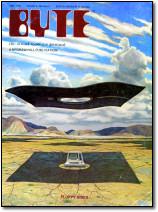 Tinney’s BYTE artwork is amazing. It displays unparallelled creativity in the use of visual metaphors to convey typically intangible, abstract, and sometimes abstruse technical concepts. His illustrations penetrate all pretense and cut straight to the heart of the main idea of the topic at hand, laying it out in an appropriately minimalistic fashion that, while sometimes visually spartan, richly sparks the imagination and places the viewer firmly in the scene. His work communicates, and it does so in ways that words never could. For most commercial artists, the idea of illustrating for a completely new field without artistic precedent would probably be daunting, if not completely nervewracking — and who’s to say it wasn’t for Tinney — but despite that immense challenge, he pulled off the assignment not only handily, but with the kind of proficency and mastery that made the genre, in this writer’s humble opinion, firmly his own.
Tinney’s BYTE artwork is amazing. It displays unparallelled creativity in the use of visual metaphors to convey typically intangible, abstract, and sometimes abstruse technical concepts. His illustrations penetrate all pretense and cut straight to the heart of the main idea of the topic at hand, laying it out in an appropriately minimalistic fashion that, while sometimes visually spartan, richly sparks the imagination and places the viewer firmly in the scene. His work communicates, and it does so in ways that words never could. For most commercial artists, the idea of illustrating for a completely new field without artistic precedent would probably be daunting, if not completely nervewracking — and who’s to say it wasn’t for Tinney — but despite that immense challenge, he pulled off the assignment not only handily, but with the kind of proficency and mastery that made the genre, in this writer’s humble opinion, firmly his own.
It was with all these superlatives in mind (and a stack of 1987 BYTEs as my bedside reading material) that I recently requested an email interview with Robert Tinney. I am delighted to say that he accepted the offer, and you can read the result below.
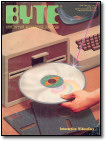
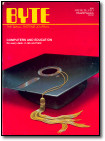
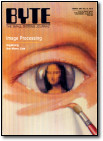
An Email Interview with Robert Tinney
Robert Tinney: As a kid I could always draw better than anyone else and I got attention that way, so I guess I always dreamed that art would be the perfect career for me. I graduated college with a degree in Advertising Art.
VC&G: How did you get started doing illustrations for BYTE magazine?
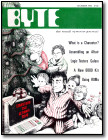 RT: Out of the army, I moved to Houston and found a variety of jobs as an artist or designer in the early 70s. Then one day a friend introduced me to an acquaintance of his, a fellow by the name of Carl Helmers, who was a consultant from the Northeast working at NASA (as I recall, his project had to do with software for the shuttle…?) Carl was full of information and enthusiasm about the new developments in transistors, etc., which he felt would revolutionize computers. This meeting was my great good fortune, because when Carl went back home, it wasn’t long before he became the founding editor of BYTE Magazine. Another piece of good fortune for me was that “Scientific American” was one of Carl’s favorite publications, and he loved the beautiful illustrations on their covers. One day the phone rang in my Houston apartment and it was Carl wanting to know if I would be interested in painting covers for BYTE. BYTE’s first issue was Sep. 1975, and my first cover was the Dec. 1975 issue, with the theme “Computers: The Ultimate Toys.”
RT: Out of the army, I moved to Houston and found a variety of jobs as an artist or designer in the early 70s. Then one day a friend introduced me to an acquaintance of his, a fellow by the name of Carl Helmers, who was a consultant from the Northeast working at NASA (as I recall, his project had to do with software for the shuttle…?) Carl was full of information and enthusiasm about the new developments in transistors, etc., which he felt would revolutionize computers. This meeting was my great good fortune, because when Carl went back home, it wasn’t long before he became the founding editor of BYTE Magazine. Another piece of good fortune for me was that “Scientific American” was one of Carl’s favorite publications, and he loved the beautiful illustrations on their covers. One day the phone rang in my Houston apartment and it was Carl wanting to know if I would be interested in painting covers for BYTE. BYTE’s first issue was Sep. 1975, and my first cover was the Dec. 1975 issue, with the theme “Computers: The Ultimate Toys.”
VC&G: Do you consider yourself a computer enthusiast yourself, or were you just kinda thrown in to the whole thing through working with BYTE?
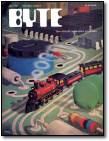 RT: I do love personal computers, just because they are such fascinating and powerful tools. But my educational background was not technical at all, so I always felt a little uneasy around all the BYTE editors all those years, since I didn’t quite speak their language. However, I’ve always thought that my interpretation of computer issues with non-technical visual metaphors was what gave my illustrations their distinctive character. So maybe that was a case of making lemonade out of lemons…
RT: I do love personal computers, just because they are such fascinating and powerful tools. But my educational background was not technical at all, so I always felt a little uneasy around all the BYTE editors all those years, since I didn’t quite speak their language. However, I’ve always thought that my interpretation of computer issues with non-technical visual metaphors was what gave my illustrations their distinctive character. So maybe that was a case of making lemonade out of lemons…
VC&G: What was the first computer you ever owned? What computer(s) did you use the most throughout the BYTE years?
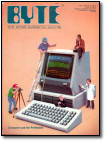 RT: I still remember how thrilled I was at a West Coast Computer Faire in the late 70s when the owner of Priority One Electronics offered to trade me a computer for a cover for an issue of his product catalog. And it was a nice one, too — a 6 MHz Morrow CP/M machine with dual 360K floppies, and software (WordStar) included! At that time my brother was studying computer science in college, and he had acquired a KayPro — one of those barely luggable boxes with the… what?… 5 inch screen? I remember him visiting one day and admiring my new Morrow. When we booted it up he was amazed at its speed. The KayPro ran at 2 MHz. I always tried to upgrade to the plateaus. From the Morrow I went to the IBM AT platform with the new 20 Meg H/D standard, then to a 486 Gateway, then to a Dell 600 MHz Pentium, and now I’ve got both the Dell and my new one (which my neighbor across the street built for me), with a 1.6 GHz AMD, 1 Gig RAM, two 80 Gig H/D, etc. (I’m much more into Photoshop than any video stuff or gaming, so I really don’t need a lot of muscle.)
RT: I still remember how thrilled I was at a West Coast Computer Faire in the late 70s when the owner of Priority One Electronics offered to trade me a computer for a cover for an issue of his product catalog. And it was a nice one, too — a 6 MHz Morrow CP/M machine with dual 360K floppies, and software (WordStar) included! At that time my brother was studying computer science in college, and he had acquired a KayPro — one of those barely luggable boxes with the… what?… 5 inch screen? I remember him visiting one day and admiring my new Morrow. When we booted it up he was amazed at its speed. The KayPro ran at 2 MHz. I always tried to upgrade to the plateaus. From the Morrow I went to the IBM AT platform with the new 20 Meg H/D standard, then to a 486 Gateway, then to a Dell 600 MHz Pentium, and now I’ve got both the Dell and my new one (which my neighbor across the street built for me), with a 1.6 GHz AMD, 1 Gig RAM, two 80 Gig H/D, etc. (I’m much more into Photoshop than any video stuff or gaming, so I really don’t need a lot of muscle.)
VC&G: About how many BYTE Magazine covers and interior illustrations did you do throughout the years?
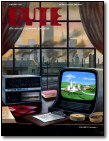 RT: I recall, I painted 80-some-odd covers for BYTE over the years, and many more interior illustrations. My last cover must have been in 1989, or thereabouts. For the first few years BYTE kept the original paintings and framed them for display in their offices in Peterborough, NH., where I’d see them when I made my yearly trek during the second week of October, during the autumn peak. Later the magazine gave the originals back to me — but unfortunately not before several of the really nice ones had been given away to big advertisers, or ended up on the walls of the McGraw-Hill Building in New York when the big publisher owned BYTE.
RT: I recall, I painted 80-some-odd covers for BYTE over the years, and many more interior illustrations. My last cover must have been in 1989, or thereabouts. For the first few years BYTE kept the original paintings and framed them for display in their offices in Peterborough, NH., where I’d see them when I made my yearly trek during the second week of October, during the autumn peak. Later the magazine gave the originals back to me — but unfortunately not before several of the really nice ones had been given away to big advertisers, or ended up on the walls of the McGraw-Hill Building in New York when the big publisher owned BYTE.
VC&G: How and in what form did BYTE give you the illustration assignment every month? How much freedom did you have to interpret their request?
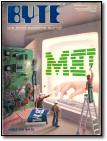 RT: I would generally check in with the BYTE editors several weeks before the deadline. The editor and I would chat for 15 or 20 minutes about the cover theme for the upcoming issue, while I took notes and tried to think of leading questions. I’d try to steer the editor away from proposing actual ideas for the art, focusing instead on what editorial issues would be addressed and how they would be treated in the various articles. Then I’d get to work coming up with metaphors and doing sketches, trying this and that. If I hit on something I really liked I’d FedEx a single sketch to them — or I might do several so that we could establish a direction first, and then work up a final layout afterwards. (I was just getting started with BYTE at the same time FedEx was establishing a foothold. I remember taking my sketches — and originals — down to the FedEx office in Houston, near the airport, for next day delivery, a really astonishing new service back in those days. Over all the years of next day deliveries to BYTE, FedEx never lost or even creased a single piece.)
RT: I would generally check in with the BYTE editors several weeks before the deadline. The editor and I would chat for 15 or 20 minutes about the cover theme for the upcoming issue, while I took notes and tried to think of leading questions. I’d try to steer the editor away from proposing actual ideas for the art, focusing instead on what editorial issues would be addressed and how they would be treated in the various articles. Then I’d get to work coming up with metaphors and doing sketches, trying this and that. If I hit on something I really liked I’d FedEx a single sketch to them — or I might do several so that we could establish a direction first, and then work up a final layout afterwards. (I was just getting started with BYTE at the same time FedEx was establishing a foothold. I remember taking my sketches — and originals — down to the FedEx office in Houston, near the airport, for next day delivery, a really astonishing new service back in those days. Over all the years of next day deliveries to BYTE, FedEx never lost or even creased a single piece.)
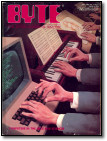 VC&G: Who did you typically interface with at BYTE to get your assignment?
VC&G: Who did you typically interface with at BYTE to get your assignment?
RT: I would deal with a different editor from month to month, depending on which one was in charge of shepherding the articles for the cover theme.
VC&G: About how long did you spend on producing a typical BYTE illustration?
RT: The final [cover] painting usually took about a week to paint, once the design was approved.
VC&G: What medium did you typically use to illustrate for BYTE?
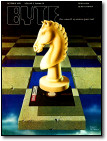 RT: Nearly all of the BYTE illustrations were airbrushed in the Designer’s Gouache medium. This comes in small tubes like watercolor — and it is similar to traditional watercolor — but the colors are opaque and very intense, which makes the paintings very easy to scan for commercial reproduction. Also, the colors are very smooth and high quality, making them excellent for use with the airbrush. I think this gave BYTE’s covers a sort of high-tech, surrealistic look consistent with its cutting edge personal computer themes.
RT: Nearly all of the BYTE illustrations were airbrushed in the Designer’s Gouache medium. This comes in small tubes like watercolor — and it is similar to traditional watercolor — but the colors are opaque and very intense, which makes the paintings very easy to scan for commercial reproduction. Also, the colors are very smooth and high quality, making them excellent for use with the airbrush. I think this gave BYTE’s covers a sort of high-tech, surrealistic look consistent with its cutting edge personal computer themes.
VC&G: What artists influenced your work with BYTE the most?
RT: Magritte and Escher are two of my favorite artists, and fans have noticed their influence in many of the BYTE designs.
VC&G: I’ve seen ads in old BYTE magazines for prints and T-shirts of your BYTE cover work. Your covers must have been pretty popular back in the day. Did you get much feedback from BYTE readers about your work with BYTE?
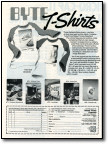 RT: A friend suggested once that I should select the best covers and reproduce them as signed prints. BYTE was gracious enough to let me advertise the prints when they could fit in an ad (it did get bumped occasionally), and the prints were very popular in the BYTE booth at the big computer shows, 2 or 3 of which my wife Susan and I attended per year. When an edition sold out, I then put the design on a T-shirt. (In fact, I still sell a few of these limited editions and shirts on eBay.)
RT: A friend suggested once that I should select the best covers and reproduce them as signed prints. BYTE was gracious enough to let me advertise the prints when they could fit in an ad (it did get bumped occasionally), and the prints were very popular in the BYTE booth at the big computer shows, 2 or 3 of which my wife Susan and I attended per year. When an edition sold out, I then put the design on a T-shirt. (In fact, I still sell a few of these limited editions and shirts on eBay.)
VC&G: Were you frequently active on BIX? [Ed. Note: BIX — short for “BYTE Information eXchange” — was BYTE’s official dial-up BBS] Did you use BIX to communicate with BYTE’s editors?
RT: Although I was on the BYTE BIX system frequently, it didn’t particularly lend itself to a back and forth chat mode, since it was primarily a bulletin board. And of course this was long before the possibility of sending sketches, which I’m sure most artists take for granted today (I certainly do). So most of my cover ideas were worked out over the phone and FedEx.
VC&G: When was your last Byte Magazine cover published?
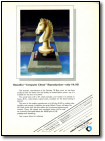 RT: Toward the end of 1987 the decision was made to change the cover to give the magazine a new image. At that point BYTE continued to commission paintings from me — but they were not covers, but rather interior illustrations for the cover theme. Also, BYTE agreed to continue giving me advertising space to sell my BYTE prints (which, after all, tended to promote the magazine). This continued for another couple of years, until in 1989 they cancelled the free ads and no longer commissioned interior art.
RT: Toward the end of 1987 the decision was made to change the cover to give the magazine a new image. At that point BYTE continued to commission paintings from me — but they were not covers, but rather interior illustrations for the cover theme. Also, BYTE agreed to continue giving me advertising space to sell my BYTE prints (which, after all, tended to promote the magazine). This continued for another couple of years, until in 1989 they cancelled the free ads and no longer commissioned interior art.
I just went through my old stack of BYTEs, and Sept. 1990 appears to be the very last cover I did. And I remember the reason I did that one was because it was their 15th Anniversary issue and they came back and commissioned one for old time’s sake.
VC&G: Do you have any feelings about BYTE’s decision to go towards using product photographs on the cover instead of illustrations? Why do you think they made the switch?
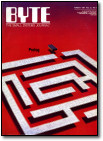 RT: The thing about BYTE was that it was the first, and for many years the virtually unchallenged, preeminent personal computer magazine. It weighed in at around 500 pages during its heyday, if I remember correctly, and the readers were nearly as interested in the ads as they were the editorial. What an advertising bonanza! BYTE was so damned successful that it could have put just about anything it wanted on its cover, and its readers would have welcomed it. I’ve always thought that one of the messages BYTE sent with its illustrated covers was, “Hey, I’m BYTE. The Biggest and the Best! I don’t need to clutter up my cover with bunch of hardware like those those other guys. I can afford to entertain you with a touch of class!”
RT: The thing about BYTE was that it was the first, and for many years the virtually unchallenged, preeminent personal computer magazine. It weighed in at around 500 pages during its heyday, if I remember correctly, and the readers were nearly as interested in the ads as they were the editorial. What an advertising bonanza! BYTE was so damned successful that it could have put just about anything it wanted on its cover, and its readers would have welcomed it. I’ve always thought that one of the messages BYTE sent with its illustrated covers was, “Hey, I’m BYTE. The Biggest and the Best! I don’t need to clutter up my cover with bunch of hardware like those those other guys. I can afford to entertain you with a touch of class!”
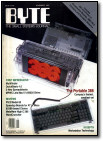 Needless to say, competition was inevitable, and as the years wore on the sales force began to complain that the magazine was beginning to have an image problem; the competition was painting BYTE as an old dinosaur, stuck in the past, catering to the old hackers and not paying enough attention to the new generation of IT professionals, etc., etc. Anyway, there’s no easier way to change your image than by changing your cover, so in the late 80s (1987 I think) the decision was made to go with a more lively (busy), competitive cover.
Needless to say, competition was inevitable, and as the years wore on the sales force began to complain that the magazine was beginning to have an image problem; the competition was painting BYTE as an old dinosaur, stuck in the past, catering to the old hackers and not paying enough attention to the new generation of IT professionals, etc., etc. Anyway, there’s no easier way to change your image than by changing your cover, so in the late 80s (1987 I think) the decision was made to go with a more lively (busy), competitive cover.
VC&G: What are you up to these days? Still in the illustration business?
RT: I did illustrations for many different electronics companies after [Byte], among them JDR Microdevices, Jameco Electronics, Quantum Software, etc. Nowadays I’m doing oil portraits, and am getting into other things as well.
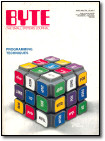 VC&G: What’s your preferred illustration medium these days? Do you still airbrush, or do you mostly do computer work now?
VC&G: What’s your preferred illustration medium these days? Do you still airbrush, or do you mostly do computer work now?
RT: I’ve pretty much retired my old compressor and airbrush; Photoshop is now my preferred medium for commercial work, for both sketches and final image. Anything I can do with gouache and an airbrush, I can do about 3 times better with Photoshop — plus I don’t have to breathe the fumes!
VC&G: And finally, do you have any advice for people who might want to become professional illustrators?
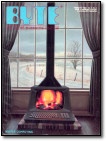 RT: Hmmmm…. illustration is one of those professions whose past is probably far more interesting than its future. Back in the days of America’s golden age of illustrators, men like Leyandecker, Flagg, Parrish, Pyle, Rockwell and Wyeth were being paid in the lower 4 figures ($2000, $3000, a little later $5000) for covers for the big magazines such as The Atlantic Monthly. (These were the days when you could buy a modest home for $1500.) Nowadays there’s certainly a lot more demand for created images — but you can also easily go to an online stock illustration site, search their database of thousands and thousands of created images, and download a digital file of your favorite for a couple hundred dollars.
RT: Hmmmm…. illustration is one of those professions whose past is probably far more interesting than its future. Back in the days of America’s golden age of illustrators, men like Leyandecker, Flagg, Parrish, Pyle, Rockwell and Wyeth were being paid in the lower 4 figures ($2000, $3000, a little later $5000) for covers for the big magazines such as The Atlantic Monthly. (These were the days when you could buy a modest home for $1500.) Nowadays there’s certainly a lot more demand for created images — but you can also easily go to an online stock illustration site, search their database of thousands and thousands of created images, and download a digital file of your favorite for a couple hundred dollars.
Being a talented artist is sort of like being a talented speaker: it’s a nice talent to have, but it isn’t easy to find someone who’ll pay you just to do it. You need to combine that basic talent with another skill to really have a marketable service. If you’re a good speaker, combine that with a law degree to be a trial attorney. If you’re an artist, acquire an expertise in 3-D modeling and move to Hollywood for a career in special effects.
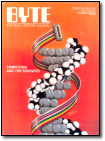
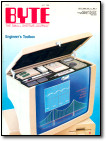
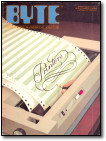


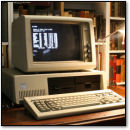
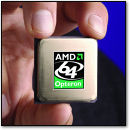
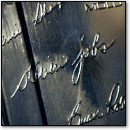
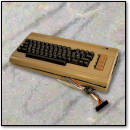
September 26th, 2006 at 1:28 pm
That is a nice story.
September 26th, 2006 at 3:36 pm
Robert is a personal friend of mine, and it’s nice to see his talent acknowledged.
September 26th, 2006 at 5:54 pm
Great interview, RedWolf. Good job!
September 26th, 2006 at 8:57 pm
Hey, Robert. Stephen sent me the link and I read every word. I’m forwarding the article to a few friends whom I have given your prints to, and I still have mine hanging in my office. Good going!
September 26th, 2006 at 10:03 pm
What a wonderfull collection !
Kudos.
Shinder Jandu
September 26th, 2006 at 10:32 pm
Very nice interview, RedWolf. I’ve been a friend of Robert’s since the mid 1970’s and have had the great pleasure of witnessing his creativity first hand from just about the onset of his association with Byte magazine and those brilliant illustrations.
Thinking back on those early days in his studio as we tried to figure out things like the intricacies of a new fangled 3000 baud rate modem still warms my aging heart. Watching his ideas grow from a humble pencil sketch to a finished cover was most fullfilling for me.
Not only is Robert the kindest man I have ever known, but he is also, by far, the wittiest. It is wonderful to see his work recognized.
October 3rd, 2006 at 1:18 am
I recall how big … THICK … Byte got for a time back in the early 1980s. It was like a monthly Sears catalog of computing.
I subscribed to rival Peterbourough magazine Kilobaud from issue #1 (still have it); Byte sure ate their lunch.
Good idea for an interview, interesting and informative. I actually remember some of those covers! They were distinctive and highly attractive.
June 11th, 2007 at 10:02 am
Just read this article while looking for Robert Tinney print values on Google.
I collected all 42 prints from Robert as a fellow Baton Rouge, Louisiana resident. My collection is all numbered 100 of the totel issued in that print. I chose this number at the time of the first printing as prints 1 and 2 were already taken. Some of these prints were kept on my office walls until I decide to preserve the collection for its future value which this article just confirms.
November 20th, 2008 at 12:16 pm
Even several years later this interview is still entertaining and relevant.
Thanks
September 16th, 2010 at 6:52 am
I was a hugely devoted reader of Byte in the UK throughout the eighties. Byte was, as Robert Tinney says here “The unchallenged, preemininent personal computer magazine”. Mr Tinney’s cover illustrations were the cool, enigmatic, icings on those 300-layer techno-cakes! : )
October 19th, 2010 at 2:29 pm
I grew up reading Byte in my teens, always loved every cover, and all the software/hardware project goodies inside. What a magazine it was, and sometimes will still pull one out. I recognize many of the covers above, there should be an online viewing library of re-scans of the original paintings! Was so bummed out as soon as the covers went and it was taken over by nothing but reviews.
That first cover is hilarious, thanks for the wonderful work!
November 14th, 2011 at 4:24 pm
I worked for IBM UK in the early 80’s in the group responsible for bringing the IBM PC to Europe. It was a complete success story at that time, and BYTE was one of the mags we subscribed to. As a marketing type I found the contents hard going, but as one who believes a picture tells a thousand words, I was intrigued by their covers. Like a Rockwell can bring a tear, Tinney is humourous and thought provoking. I bought “Inside IBM”, 101 of 500, directly from the man, as a result of the adverts referred to above, and remember the pleasure I experienced when it arrived. It is still on the wall, framed, here in my home in London, and reminds me of those early PC days, and my time in IBM.
June 21st, 2012 at 8:07 pm
So, I was right: the loss of his covers /did/ coincide with the start of the general decline of the magazine–though it never went as far downhull as some of the others….
but the Tinney years– ‘prioceless’
pgf
April 15th, 2014 at 1:48 am
Man, those were the days I remember of a time where there was just the excitement of a new unexplored universe coming into being….no drm, no ms registry, no bull, just a new age where you could finally make or buy your very own computers…. I espesially liked the cover where the Star Trek crowd I’d looking at the life sized musium display of a 20th century computer programmer and his equipment trying to get programming done and they can’t stop laughing!!
July 13th, 2015 at 3:34 pm
I remember Robert and his illustrations very well indeed. I was the assistant art director at Byte from 1986 until the magazine closed in 1998 and have several of his signed prints at home. A very talented, and personable man.
October 29th, 2015 at 11:05 pm
A picture is worth 1000 words, and in many cases Robert’s wonderful illustrations captured the ‘Soul’ of that issue.
I grew up with Byte and followed it almost religiously till it ended. It was always a point of excitement to get the latest issue and then hermit myself somewhere so I could enjoy the articles. I still follow Chaos Manor and Circuit Cellar.
Many thanks Robert for the memories, and thanks for printing this article.
Dave
November 18th, 2015 at 9:27 pm
I must admit that I had taken the covers for granted until they switched to photos. But this article captures their essence. Now I wish I had kept every single cover.
December 19th, 2015 at 10:33 pm
I recently finished a photography project of bringing on of Mr. Tinney’s covers to life as a photograph. I chose “Computer Engineering”, the one with the train on the printed circuit board. I made a PCB similar to the one in the cover, photographed it, then photographed an H0 scale train and superimposed it on the board, along with smoke rings. You can see the result at http://www.galacticstudios.org/byte-magazine-cover/
August 11th, 2020 at 6:40 pm
I bought my first Byte Magazine in December 1991, recently graduated in Information Systems.
I became a fan of the magazine and the illustrations always seemed more than striking.
I think there are two types of graphic artists: those who think and those who make you think.
Robert Tinney belongs to the latter. His illustrations first grab attention and then convey a related concept or group of ideas to you. Superb.
May 28th, 2021 at 9:45 am
The prescience of the artist is remarkable. Most people can’t seem to imagine what’s around the very next corner, let alone years in advance across disparate disciplines. Truly, BYTE should have stuck with its original-style covers. Looking back, what a “me too” they knuckled under to…
September 30th, 2022 at 12:06 pm
Hello – I bought a number of signed prints of Robert Tinney when I started my first business in 1980. I still have a numbered print of Artificial Intelligence. I am writing a short book aimed at Entrepreneurs on the trials and tribulations of running your own business and I would like to use a copy of that picture on the front. Would that be allowed? I can upload a copy of my print. I do not anticipate it will sell many copies – ,mainly intended for my family and ex-employees and I have never written a book before, I am running a new startup in online learning so I must be a glutton for punishment! I am living in London.
Would you be able either to give me Robert’s address or forward this to him please? hanks – I look forward to your reply
March 3rd, 2024 at 11:43 pm
Hi! I’m fortunate enough to have Robert Tinney as my Grandfather. I actually just got back from visiting with him, and it reminded me of his amazing artwork for Byte and elsewhere. Growing up, Papa was always a man of few words. I always knew Papa was an incredibly talented artist, as we have numerous original paintings of his in my childhood home, but it wasn’t until much later in my life when I found out how truly accomplished he was. He is the most humble and down to earth man I’ve ever met. I admire him so deeply. Incredibly accomplished and talented, yet not one boastful word out of his mouth ever. It’s so nice seeing people admire his work as much as I do. His Byte covers were incredibly creative and executed with such detail, he really was the soul of the magazine. He put so much meaning behind every thing he created. My brother currently has all of Papa’s original Byte prints, and it’s sage to say I’m incredibly jealous. Unfortunately, Papa isn’t making art anymore, but he is doing great! I love seeing how admired he is. Thank y’all so much for supporting him, he truly deserves all the praise in the world.